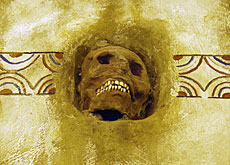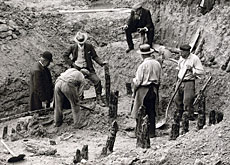Rethinking the Celts

Few ancient peoples are better known than the Celts, but few are also shrouded in such mystery.
An exhibition on Celtic religion, which has opened at the Laténium Museum in Neuchâtel in western Switzerland, draws on recent archaeological discoveries to cast light on what the Celts’ religious practices and beliefs really were.
The exhibits on show date from around 450 BC, the start of the most famous Swiss Celtic site of all, La Tène on Lake Neuchâtel, until the end of the 2nd century, well into the Roman period.
From the Greeks and Romans to the modern day, the Celts have been demonised as bloodthirsty barbarians practising human sacrifice or romanticised for their alleged closeness to nature.
“This exhibition shows where we have got so far in the archaeological rediscovery of Celtic religion,” Marc-Antoine Kaeser, director of the Laténium Museum, told swissinfo.
“Where archaeology is particularly useful is when it comes to reconstructing ritual practices. We have to try to make a connection between what we know about their mythology and the practices. And that isn’t always obvious.”
Belief system
Celtic tribes dominated a large area of Europe for several centuries, so it is not surprising that their beliefs and practices varied.
Geographically, the exhibits range from a beautiful silver cauldron found in Gundestrup in Denmark, whose decorations show Celtic gods and rituals, to the reconstructed portico of a shrine in southern France.
The Celts believed that the stars determined human existence. Their belief system is illustrated mainly through their artwork, since it was not written down.
At the centre of the introductory part of the exhibition is the Kermaria stone, which represented the navel of the world, from which sprang the tree that held up the sky. Statuettes, and jewels and weapons featuring humans or animals, represent the Celtic gods.
Role of skulls
But after this, much of what is on show will appear gruesome to modern visitors once they pass under the reconstructed gateway of a 4th-century BC sanctuary excavated in northern France.
The gateway is decorated not only with trophy shields but also with animal and human skulls. The first thing the visitor sees on the other side is the corpse of a sacrificial bull, lying in an altar pit and left to rot.
“They have practices which seem very strange to us, but it all happens in very specific places, according to codified norms,” Kaeser said.
Among the items from this sanctuary is a human skull, cut to form a mask for display, and other human bones treated in various ways as part of religious rituals.
While the first sanctuary illustrated in the exhibition was a special place kept apart from everyday life, the two others on show were in the middle of town. One is a large enclosure discovered in the Auvergne region of central France; the other, from a site further south, is a covered portico with the statue of a god or an ancestor, and again set around with human skulls.
It is not known whether the skulls came from the victims of sacrifice, or whether heads were removed immediately after death from other causes. However, the exhibition of skulls was undoubtedly a show of respect for the dead, according to Kaeser.
“Those people had a different relation to death than we do today. Death belongs to life and human experience,” he said, stressing that the dedication of human body parts to the gods was part of a specific ritual.
Kaeser rejects the air of romantic mystery that some people attach to the Celts.
“There is no mystery, there are only misunderstandings. We are shedding light on those misunderstandings, we are trying to see those people not as the ‘other’ but as part of our heritage,” he explained.
swissinfo, Julia Slater in Neuchâtel
The exhibition “Par Toutatis!” runs at the Laténium Museum in Hauterive, Neuchâtel, from October 19 to June 1 2008.
It is based on an exhibition first seen at the Lyon-Fourvière Gallo-romain Museum in Lyon, France, enhanced with new items from Swiss museums.
La Tène is a Celtic site on the northern shore of Lake Neuchâtel, which gave its name to the second Iron Age in Europe.
The La Tène culture lasted from about 450-50BC.
The Romans referred to the Celts as Gauls. The Romans conquered the Gauls of most of modern France and Switzerland between around 60 and 50BC.
Roman accounts of the Celts tend to be hostile, depicting them as bloodthirsty barbarians.
Until the archaeological excavations of the past 30 years, most modern knowledge of the Celts was based on Roman and Greek sources.

In compliance with the JTI standards
More: SWI swissinfo.ch certified by the Journalism Trust Initiative

You can find an overview of ongoing debates with our journalists here. Please join us!
If you want to start a conversation about a topic raised in this article or want to report factual errors, email us at english@swissinfo.ch.